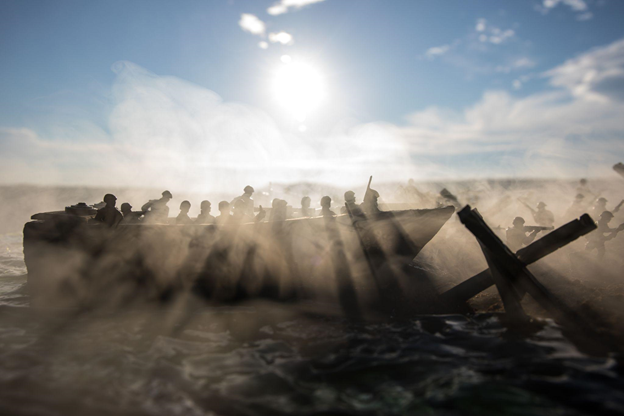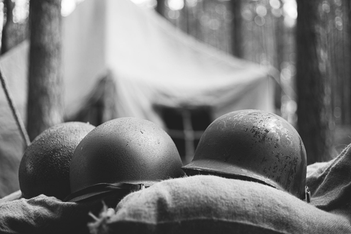A Super-Short History of the M1 Carbine
Apr 22nd 2025
The M1 Carbine hit the scene a little later than its larger, more powerful cousin, the M1 Garand, which was already in service at the outbreak of the Second World War for the United States.
Unlike its much heavier counterpart, the M1 Carbine was actually expressly designed to offer lighter, easier handling in a more compact package than the Garand. It was also designed to offer reasonable firepower at close and intermediate ranges.
Its role as a lighter infantry rifle, as a support for other troops carrying the Garand, began in 1940. The idea was that troops at the rear, such as medics and military police, should be equipped with a lighter rifle that was easier to handle than the Garand. The way the Army saw it was that these personnel were still at risk of attack, but shouldn’t have the need to have to carry a larger and more powerful rifle. Something intermediate would get the job done.
Apparently, the design of this rifle was influenced by the success of the Germans’ Blitzkrieg tactics in Europe. Lightly equipped troops and fast-moving tanks and artillery, protected by air support, could quickly advance into hostile territory, even putting the troops in the rear guard at risk - all this, over a year before America even entered the war.
The new design, it was hoped, would offer significantly more firepower than a sidearm like a handgun, but would be lighter and more maneuverable than a full-sized battle rifle or a submachine gun.
This new carbine was built around a .30-caliber cartridge, like the Garand, albeit one that was much smaller and lighter. This new .30 Carbine cartridge was closer, relatively, to a pistol cartridge, with a straight-walled case and a standard 110-grain bullet. Somewhere between a rifle cartridge but still more powerful than a .45 ACP round, the .30 Carbine offered an (approximately) effective range of 300 yards or so.
Interestingly, the production of the M1 Carbine began in August 1941, just a few months before America entered WW2. It entered service in 1942, and during the course of the war, more than 6 million rifles were produced.
Early in the service history of the M1 Carbine, it was outfitted with a detachable 15-round box mag. Later, 30-round “banana” mags were developed for it, but these didn’t hit the scene until after World War II.
A number of the M1 Carbines produced were of a variant known as the M1A1, which was designed to be issued to paratroopers. It featured a side-folding metal stock that collapsed its footprint and made it lighter, more compact, and easier to carry. After 1942, it was issued to all airborne units as well as to the Marine Corps.
While it was originally designed for issue to rear troops, the need for greater production and more weapons meant that eventually, some units closer to the front line were equipped with it. Troops appreciated its lightweight design and handling, but the weapon was not without its drawbacks.
Most notably, the M1 Carbine delivered somewhat specious stopping power and questionable range. It certainly lacked the formidable stopping power of the Garand’s .30-06, despite the fact that it offered a lot more than the .45 of the M1911.
Another issue with the M1 Carbine was - and this is huge - that the early sights were not adjustable for windage - making them basically useless unless the operator learned how to compensate for their inherent inaccuracies. That’s not a very good design for a service rifle.
Originally, the M1 Carbine was initially issued without bayonet lugs, unlike the Garand which was equipped with lugs for the M1905 or M1 bayonet. Later in its history a lug was added, but the first M1 Carbine rifles were issued with M3 fighting knives that were intended for combat and utility, rather than as a bayonet.
By 1944, a variant of the M1, the M2 Carbine, was developed which included a selective fire switch that enabled fully-automatic fire. There was also another variant known as the M3, which was equipped with an infrared scope, for night-time operations.
Despite these shortcomings, the M1 Carbine was, overall, a fairly popular rifle platform. What’s interesting is that in instances in which the Germans captured them they were recycled into service as “Selbstladekarabiner” 455a rifles.
That, coupled with the fact that the M1 Carbine saw service through Korea and Vietnam, and was distributed to other countries, makes the case for its place in history. It certainly was one of the more influential mass-produced American designs of the 20th century.

Here for an M1 Carbine or M1 Carbine Parts?
In the event that you’re here M1 Carbine parts, you’re in the right place. Check out the full collection via the previous link and get in touch with us if you need help finding something specific. We’ll help you find it.

